|
An Excerpt from The History of Motion Graphics:
Mary Ellen Bute (1906 � 1983) was originally trained as a painter at the Pennsylvania Academy of Fine Arts in Philadelphia. After graduating in the early 1920s, she moved to New York and became involved with the same concerns with movement, rhythm and synaesthetic form that were common to the European avant-garde before World War II. Her engagement with these issues is apparent through her associations: she was closely involved with the community of visual music inventors and musicians in New York in the 1920s and early 1930s. During this period, she worked in the studio of Leon Theremin, and it is likely that through this connection she encountered Schillinger who was collaborating with Theremin on the development of the electronic musical instrument that bears his name; Bute read the paper about this instrument while Theremin demonstrated it to the New York Musicological Society. She would later also work in Thomas Wilfred�s studio, learning to perform on the Clavilux.
Her movement between live performance of electronic and visual music, the aesthetics of abstract painting influence and her work with adapting Joseph Schillinger�s mathematical model for synchronization of sound-image draws all the various threads of the history of motion graphics together in her film work, which she termed�in a direct reference to both visual music and the American abstract painter Stanton MacDonald-Wright�s art �movement� of the same name�Synchromy; she would produce ten abstract films between 1936 and 1959.
Bute�s activity as an abstract film maker began as an attempt to produce a visual demonstration of music theorist/mathematician Joseph Schillinger�s system for synchronizing music and image. Understanding Schillinger�s musical system is essential to comprehending the formal development of Mary Ellen Bute�s films; it occupies a central position in the aesthetics governing her film works. The earliest of these are directly relatable to the theoretical work produced by Schillinger. Her first attempt at an abstract film, Synchronization (1933), was never completed, but was meant to be a logical demonstration of Schillinger�s ideas.
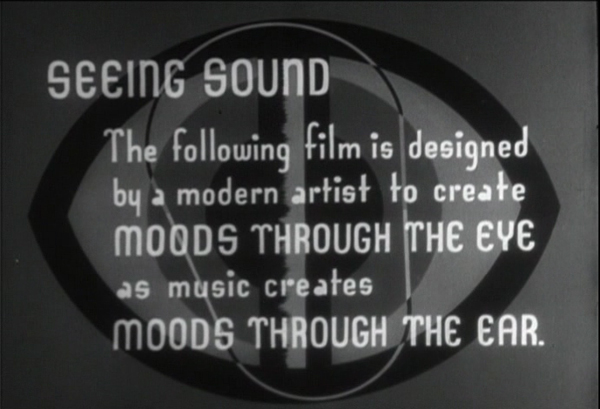
Schillinger�s music theories have many points of contact with the tactics of avant-garde artists working in the visual arts: he would attack and ridicule established conventions, arguing for a new model for music that he was proposing. The musical system is part of Schillinger�s larger system of art that is principally modeled on the permutation of Aristotle�s five senses. Music historian Warren Brodsky explains Schillinger�s invention in his survey of the theorist�s work:
This permutational approach to the arts (forty years before the computer era) defined eighteen different art forms involving sound, mass, odor, flavor, light, pigment and surface relation to general components of time and space. He spoke of synthetic and multisensory associations, as well as about the fusion of sensations, which we referred to as �colored hearing,� �sound seeing� and �kinesthetic temperature / texture reactions� of tone quality. Schillinger also raised the question of transformation and coexistence of optical forms based on musical patterns.
[Warren Brodsky. �Joseph Schillinger (1895�1943): Music Science Promethean,� American Music (Spring 2003), pp. 54-55.]
Mary Ellen Bute�s films show their influence from Schillinger directly: many are titled specifically as �A Seeing-Sound Film,� or as �Synchromy�. The connections between synaesthetic abstraction, the production of a �universal language of form� and both visual music and film could not be more explicit than in Brodsky�s listing. The construction of art around the synthesis of discrete senses and the fusion of sensation as �colored hearing� is a common theme among artists involved with the synaesthetic tradition. In working out the potentials of his system, Schillinger proposed several approaches to the synchronization of music to visuals, patenting devices of two types: the �Graphomaton� that produced linear designs, and the �Luminaton� that employed projected light. The development of machineries to demonstrate the theoretical connection between sound and image, as well as the free movement between various types of �color organ� and film experiments, is one common feature shared by a majority of artists working in the first period of abstract film. Mary Ellen Bute�s work and close connections to Schillinger, Theremin and Wilfred has a visible impact on how she develops and experiments with creating visuals for her abstract films; central to this work are Joseph Schillinger�s theories about synchronization.
Schillinger�s approach conceptualized both film and music as similar problems where their structural organization and development was to be based on rhythm. In his model the rhythm of events (plot), actions (actor�s movements), and color (or chiaroscuro) are all coordinated to the music to create a single rhythmic effect. Bute�s first finished film, Rhythm in Light (1934) simplified the earlier visual design of Synchronization and replaced the hand-animated forms with live filming of physical objects, thus allowing the production of the finished film much more quickly than what would have been required for the animation. Unlike Oskar Fischinger�s direct synchronization of form-to-tone, Bute�s design follows an elaborate synchronization of composition, musical phrase, visible motion on screen and editing to create its linkage of sound and image. It is an almost literal adaptation of Schillinger�s description of synchronization from his February, 1934 article �Excerpts from a Theory of Synchronization� published in the Marxist film journal Experimental Cinema:
Synchronization of the visual-audible does not necessarily mean one to one correspondence. Different components can be correlated through all the infinite variety of their different powers and different modifications of the same powers. Different parameters of the same component follow the same principle. This means that the continuum of one or more components can be represented through a system of parabolas, where the location of points expressing different parameters can be determined.
[Joseph Schillinger, �Excerpts from a Theory of Synchronization,� in Experimental Cinema, no. 5 (February, 1934)]
Schillinger�s brief article presents a mathematically-based theory for cinematic construction of synchronous relationships between music and image. The foundation for this construction is the rhythmic cycle based in an assumption that the audience already knows the development and progression of the piece itself; this element of past experience and conscious anticipation of the work�s development is a crucial, but unacknowledged element in his theory:
There are different ratios of correlation serving different purposes. For instance the rhythmic center for an image on a given area will be more dynamic or dramatic at the ratio of 4:3 than at 1:1. The same is true referring to time for a whole composition: the suspension of a climax will be more effective at the ratio 3:2 than at 4:3�as it develops later, it will seem tenser.
[Joseph Schillinger, �Excerpts from a Theory of Synchronization,� in Experimental Cinema, no. 5 (February, 1934)]
The distinction between an image where the whole totality is perceived instantly, and the elaboration of a work across a duration is absent from this construction; this lapse is significant to understanding the theory Schillinger proposes. It is a conception where the organization of the whole, and its comprehension after viewing. In this theory, the full elaboration and the desired emotional effects of that construction, require a complete apperception of the totality once it is complete.
Filmmaker and historian Lewis Jacobs, whose magazine Experimental Film was engaged with promoting a politically-engaged cinema derived from Soviet work with montage, described Bute�s films as being �more concerned with complementing rather than corresponding to the visuals.� His observation about her films is appropriate: Bute�s films do not engage in the synchronization of note/tone to form that Oskar Fischinger�s films do; however, this is not to say that there is not a variety of counterpoint synchronization clearly evident in these films. Their structural organization, editing, rhythm and tonal qualities are all carefully fitted to the music, so the imagery serves as a response and a visualization of the music, but without displaying individual notes tied to specific forms throughout the entire film. The degree to which each film is synchronously connected to the music varies. Some, such as Tarantella (1940), have close synchronous relationships with forms, while others, such as Synchromy No. 4: Escape (1938), do not.
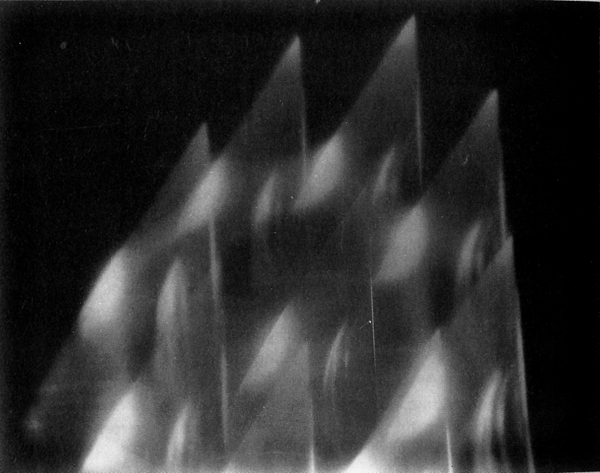
Rhythm in Light (1934)
Rhythm in Light (1934) was Mary Ellen Bute�s first completed film, appearing the same year as Schillinger�s discussion of synchronization in Experimental Cinema. It had been preceded by several studies and an earlier attempt to film Schillinger�s ideas using standard animation techniques that was abandoned because the imagery was too complex for standard production with hand animation. Rhythm in Light reflects this shift from the painterly and cel animation techniques employed by the absolute filmmakers (Ruttmann, Eggeling, Richter) in the 1920s in favor of the same procedures of abstracting from reality by using already-abstract subjects employed by Laszlo Moholy-Nagy. Running just under three minutes long, following the opening credits it proclaims itself a �A Pictorial Accompaniment in abstract forms� followed by the explanation that �It is a pioneer effort in a new art form � It is a modern artist�s impression of what goes on it the mind while listening to music.� The explanatory element in Bute�s film is a common feature of American abstract films of the 1930s produced for commercial distribution�an element also shared by Fischinger�s 1936 An Optical Poem.
Her use of commercial distribution links the independent production of Bute�s abstract films to the more contemporary independent production companies that create motion graphics. Bute retained ownership and control over her films, distributing them herself; they would screen in commercial distribution as the animated short before prestige features such as Mary of Scotland, The Barretts of Wimpole Street or Hans Christian Anderson.
Like Fischinger, Bute chose classical music that was already familiar to her anticipated audience for Rhythm in Light. The abstract forms are organized in counterpoint to Edvard Grieg�s �Anita�s Dance� from his Peer Gynt Suite. To achieve the effect of an �absolute� animation, Bute filmed various objects that already has a geometric character in such a way as to render them abstract: sheets of crumpled cellophane, an egg-cutter, prisms, toy pyramids, ping-pong balls, velvet sparklers, and bracelets. Their framing, movement and editing are responsible for creating the abstract effects seen in this film. Fully recognizable shots are kept to a minimum, and the elements seen only betray their actual, physical identity in a few shots�the majority of the material appears completely abstract, but has a sensuous quality produced through the lighting effects possible with tangible objects.
Synchromy No. 2 (1935) develops and explores the potential for using physical materials, editing and lighting effects to create abstraction with actual objects. Unlike her first film, the materials used allowed a consideration of the range between representational materials abstracted through film, and geometrically abstract objects. The lighting effects and kaleidoscopic distortions that abstract her physical source materials converged with the same kinds of effects Laszlo Moholy-Nagy employed in his earlier Ein Lichtspiel schwarz weiss grau (1930). However, the visual materials, however abstracted they are, retain their representational content: gothic arches, staircases, rippling star patterns abound throughout the five minute film. These recognizable materials are linked to the soundtrack in obvious, direct ways: as illustrative materials drawn from the musical content.
The soundtrack for Synchromy no. 2 is exceptional not only among Bute�s abstract films, but also among abstract films generally: it used a vocal performance of Richard Wagner�s The Evening Star, sung by Reinnald Werrenrath, instead of a purely instrumental score. This difference brings her film closer to the music videos of the 1970s and 80s in its effect�a visual performance that illustrates the soundtrack in a way that Fischinger�s tight tone-form synchronization does not. The illustrative dimension of this film appears through the fully representational subject of the film: a small statue of the Venus de Milo, whose role is as the �evening star� from the song. This close relationship between content of the imagery and the lyrics of the song overshadows the loose synchronization of music and image. The points of contact provide a referential framework for the elaboration of the film-as-illustration.
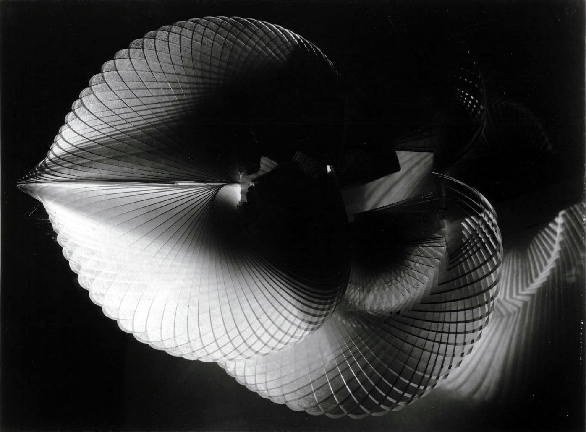
Parabola (1937)
Parabola (1937) is the last of Bute�s films to be built from careful manipulations of physical objects to achieve chiaroscuro effects in black-and-white. It employs a translucent sculpture by Rutherford Boyd whose abstract arcs and curves�supported by internal ribs�give visual form and rhythm to the film. As with Moholy-Nagy, Bute incorporates both the sculpture itself and the light patterns it produced on a wall into the finished film. The imagery of this third film is the closest to the descriptions for musical structure posed by Schillinger: his �continuum of one or more components can be represented through a system of parabolas� becomes literally visible in Bute�s film, appropriately titled �Parabola.� This connection between her work and Schillinger�s ideas is a constant feature of all the abstract films she produced.
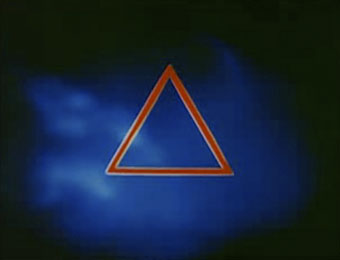
Synchromy No. 4: Escape
Synchromy No. 4: Escape (1938) introduces a series of new elements to Bute�s visual vocabulary developed in her previous films: color, kinetic light effects (the influence of Thomas Wilfred), and subsumes all these to plot set to Johan Sebastian Bach�s �Toccata� from Toccata and Fugue in D minor. The narrative drama is simple: it is the story of a red triangle in a black prison, and shows it breaking through a series of grids and bars in its process of escape, as it leads other triangles to freedom. This story synthesizes the developments of her previous films, yet does not leave the realm of visual abstraction because the various �actors� are themselves simple abstract forms. This dramatic narrative element would become more pronounced in her collaboration with Norman McLaren on Spook Sport (1940) where his hand-drawn animations tell the story of ghosts and other spirits cavorting in a graveyard after dark, synchronized with Camille Saint-Sa�ns� Danse Macabre.
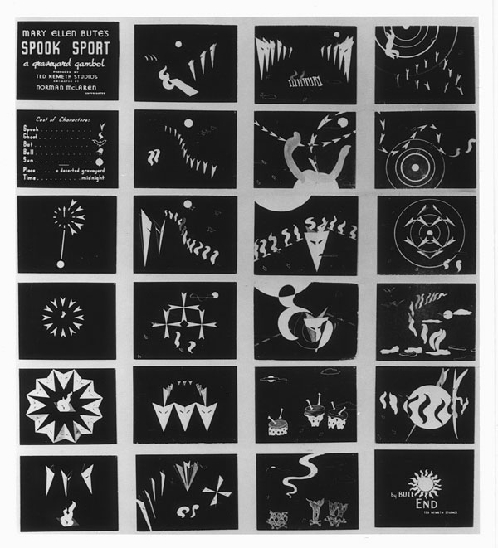
Spook Sport (1940)
Tarantella (1940) was a second collaboration with Norman McLaren, however, unlike Spook Sport it is less a narrative than an abstract dance where hand-drawn elements contrast with hard-edged geometric forms. The synchronization of tone to form is more precisely timed and achieves a visible synaesthetic effect similar to the synchronization employed by Fischinger. Her other films of the 1940s would develop these effects further.
Like Spook Sport, but unlike Synchromy No. 4, ghostly, highly-saturated color effects appear throughout the film�a product of the film being printed with a two color process. Because the film uses a pair of negatives�one the produces red and another than produced blue�when there are different animation elements are in each printing element, the resulting colors are brightly saturated and highly graphic. This is a process which McLaren would use in his other films from the 1940s.
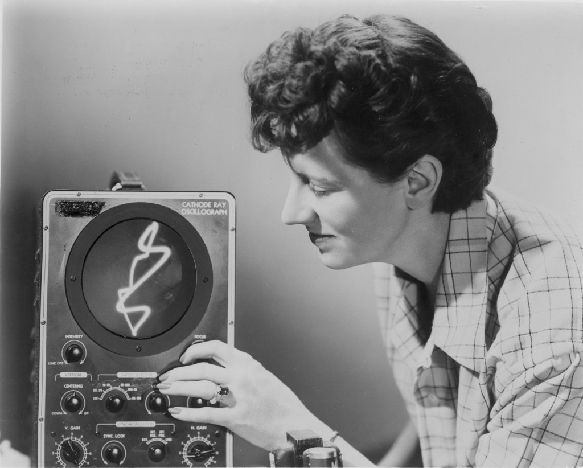
In the early 1950s, Bute worked with electrical engineer Dr. Ralph Potter, who came to her studio interested in seeing her films, on an electronic means for generating abstract animation elements. She called these works �Abstronics� for abstract electronics. This collaboration/development resulted from her explanation of the animation process and its labor-intensive process to Potter, who worked at Bell Labs in New Jersey. He designed the circuit for an oscilloscope which allowed the generation and animation of simple geometric forms that could then be filmed live and combined into finished films. Bute explained this device in an unpublished article, �Abstract Films.� It provided a means to �draw� directly on screen, and animate the drawing at the same time:
We got the pattern so that we could make it come forward or backward on the screen and move around and come in any side of the screen so that you also have horizontal and vertical control.
[Lauren Rabinovitz, �Mary Ellen Bute� in Lovers of Cinema, (Madison: University of Wisconsin Press, 1995) pp. 325.]
As an animation tool, her device anticipates developments in both video art, and other experiments with creating digital animations with the computer in the 1960s. Because it offered the ability to change the size of the form (creating the illusion of a z-axis movement), and both x and y coordinate movements, the oscilloscope controller enabled the first direct animation of abstract materials that did not require some type of physical object prior to filming�a requirement present even in the experimental wax and moir� patterns generated by Oskar Fischinger in the early 1920s. This transition from a physical object to a generally variable, artificial electronic source provides an important precedent for developments of electronic imagery in computer films and video art; the generation of imagery within a specific set of parameters is a common feature of all digital imagery.
|

|